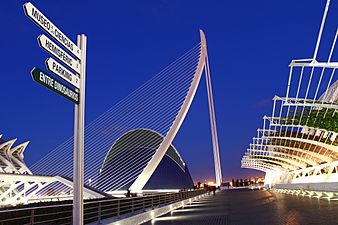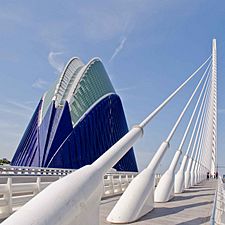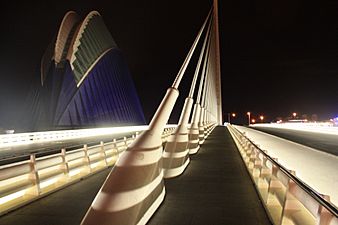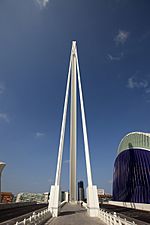Assut de l'Or Bridge facts for kids
Quick facts for kids Assut de l'Or Bridge (Serreria Bridge)Pont de l'Assut de l'Or |
|
|---|---|
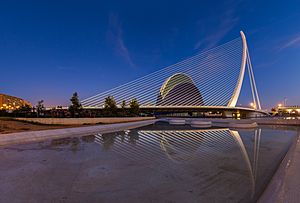
Side view of the Assut de l'Or Bridge with L'Agora in background
|
|
| Coordinates | 39°27′17.3″N 00°20′58.7″W / 39.454806°N 0.349639°W |
| Carries | six vehicular traffic lanes, two tram lanes, and two pedestrian cycling lanes |
| Crosses | Turìa Gardens (former riverbed of Turia River) |
| Locale | Valencia, Spain |
| Characteristics | |
| Design | cable-stayed bridge with a backward curved pylon |
| Total length | 180 metres |
| Height | 125 metres (making it the highest point of the city) |
| Number of spans | one with 29 cable stays |
| History | |
| Architect | Santiago Calatrava |
| Construction cost | 59.9 million Euros |
| Inaugurated | 12/12/2008 |
The Assut de l'Or Bridge is a cool white bridge in Valencia, Spain. It's part of the amazing City of Arts and Sciences complex. A famous architect and engineer named Santiago Calatrava designed it. The bridge was finished in December 2008.
Its name, l'Assut de l'Or, means the Dam of the Gold in Valencian. This name comes from an old dam that used to be nearby. But people in Valencia often call it other fun names. Some call it El Jamonero (The Ham Holder) or Pont de l'Arpa (The Harp Bridge). Calatrava himself called it the Serreria Bridge.
Contents
Bridge Design and Features
This bridge crosses the Turia Gardens in southeast Valencia, Spain. These gardens are in the old riverbed of the Turia River. The bridge is very close to the east end of the City of Arts and Sciences complex.
A Unique Cable-Stayed Bridge
The Assut de l'Or Bridge is a type of cable-stayed bridge. This means its main deck is held up by many strong cables. These cables connect to a tall tower, called a pylon.
The design of this bridge is special. Its pylon is curved backward. It is also held in place by cables that go back to heavy concrete blocks in the road. This makes the bridge look very modern and artistic.
What the Bridge Carries
The bridge deck is wide and busy. It has six lanes for cars, with three lanes going in each direction. There are also two lanes for a tramway.
In the middle of the bridge, there is a special path. This path is just for people walking and riding bikes. This makes it easy and safe for everyone to cross.
Lighting Up the Night
The bridge looks amazing at night. Special lights shine on the cables and the curved pylon. This lighting makes the bridge stand out as a beautiful landmark in the city.
Gallery
See also
 In Spanish: Puente de l'Assut de l'Or para niños
In Spanish: Puente de l'Assut de l'Or para niños
- Samuel Beckett Bridge in Dublin, Ireland, in which the forward curved pylon is also back stayed
- The Erasmusbrug in the Netherlands, another single pylon cable-stayed bridge in which the pylon is back stayed


